Pickathon 2016 [Pt 2]: Sir Richard Bishop, Yo La Tengo, Mac demarco, Moon Duo, Ty Segall, etc.
In a bold/misguided attempt to review every one of the dozen bands that we saw in one day at a music festival… here’s 5,000 words about a music festival
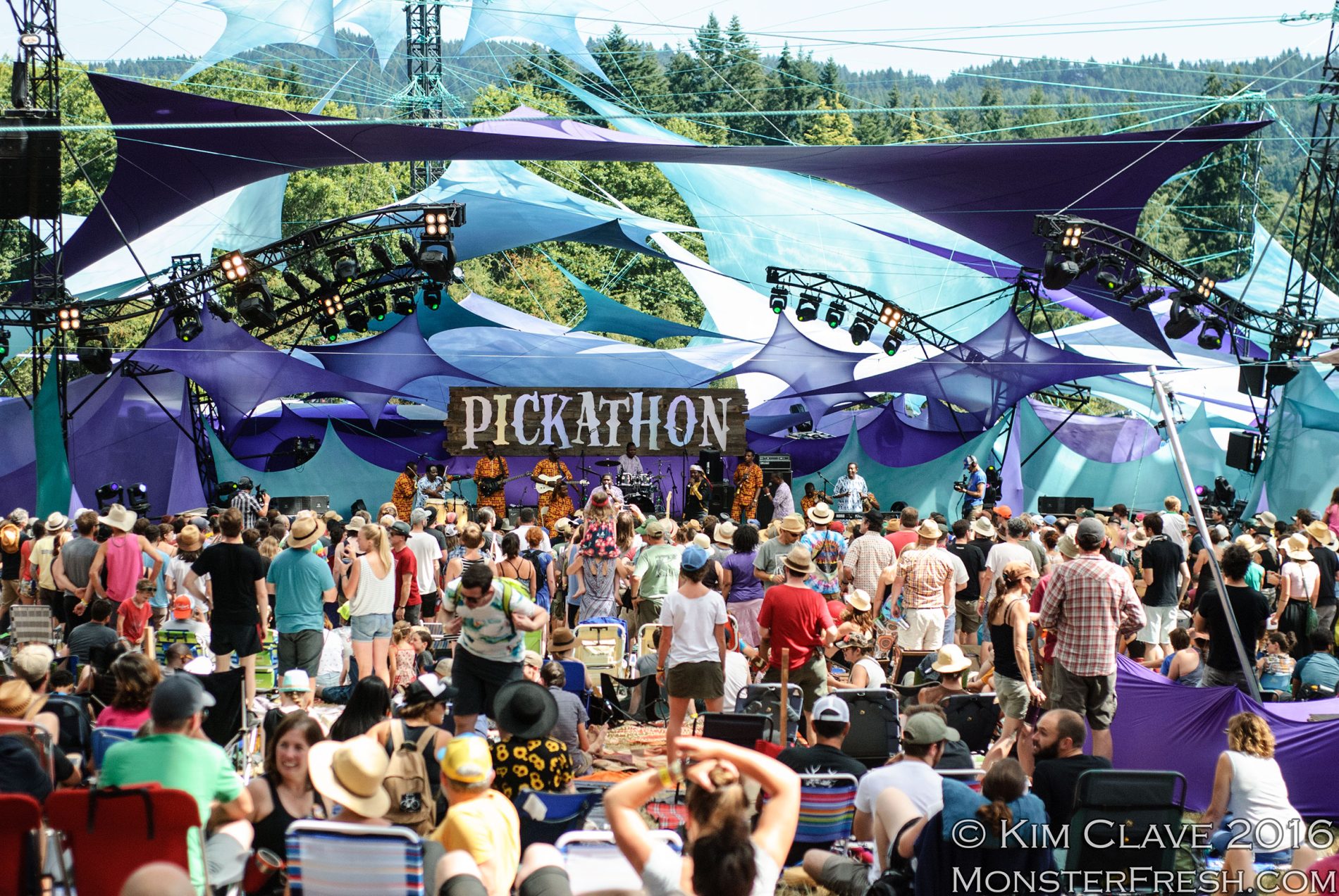
First thing in the morning, we grabbed a couple of biscuit sandwiches and then headed directly to The Woods Stage to catch Sir Richard Bishop. Erected in a clearing and equipped with row after row of seating in the form burlap draped hay bales, the aptly titled, Woods Stage is a majestic site featuring a domed canopy constructed from intertwining branches. Whenever I’ve tried to tell people in the past that Pickathon “isn’t like other festivals,” showing them a photo of the Woods stage is the thing that usually convinces them that there may be something to that. It’s hard to find much more of a contrast with the typical mainstream music festival than a stage resembling an upturned nest constructed for massive Endorian birds by Ewoks. If you ever came across anything close to it anywhere else, it would still likely be plastered in Pepsi and T-Mobile logos.
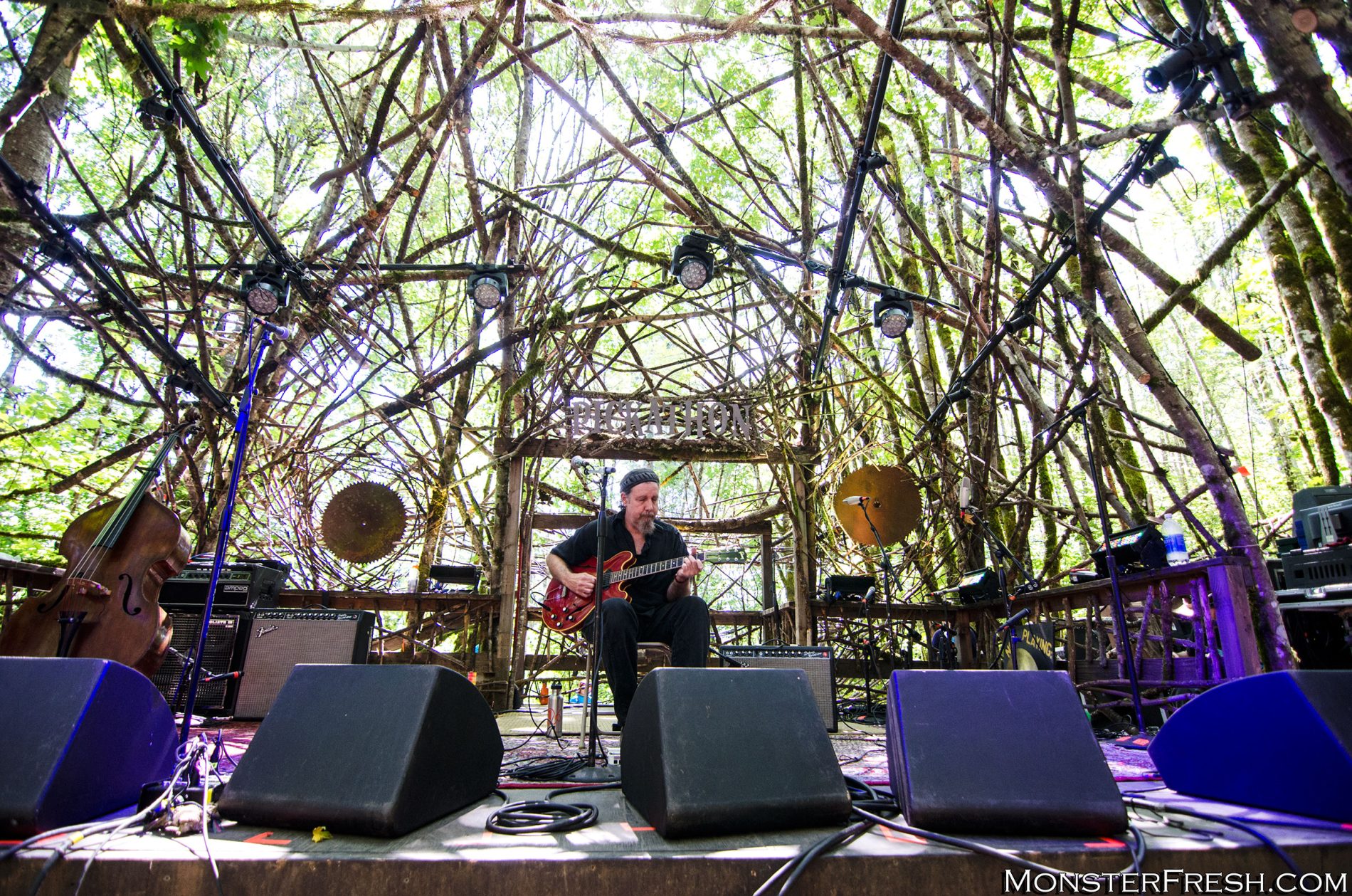
Sir Richard Bishop is an artist that I felt would be the perfect fit for Pickathon since the first time that I stepped foot at the festival. For more than 2 1/2 decades, Bishop was part of the experimental underground rock trio, Sun City Girls, who pumped out something like 67 albums, a dozen 7-inches, a half-dozen VHS cassettes full of live material, and various compilation appearances. Growing out of the Arizona punk scene and eventually landing in Seattle, their style was difficult to categorize, incorporating everything from mystic chants, audio clips, jazz, and sea chanties to corrosive noise, Eastern tripouts, and swirling psychedelia. Since venturing into solo work, the absurdly prolific guitarist has put out about another 30 albums, half of which are self-released, and has traveled extensively, studying and performing a blend of different guitar styles from around the world in various locations around the world. I’ve never seen somebody else man a guitar in quite the same way that Bishop is capable of, incorporating the fascinating beauty of Robbie Basho and the dexterity of a John Fahey, while tearing through intricate, often non-descriptly exotic guitar lines in endless exploration. But the thing that really makes what he does so crazy is that he’s pulling all of this off on an electric.
During his introduction, the woman handling the duties referenced the guitarist’s “mercurial stylings,” while promising that his set would be guaranteed to “transport” the listener. Casually seated on a foldout chair, old Rick Bishop dryly gestured widely with his hands to emphasize her remarks. From there, he went on to do exactly what she promised, offering up a small handful of lengthy and ever-changing jams, which pulled from every reach in the cosmos and beyond, seemingly, only ending them at arbitrary moments, whenever he felt that he’d worn them out. Then, onto the next one. There was a moment where he stopped to inquire about how much time he had left. He informed us that the answer was “19 glorious minutes” and then proceeded to fill them. Before leaving the stage, Bishop informed us that we would have another opportunity to catch him when he performed in the Lucky Barn on Sunday. As he explained, it would be an acoustic set and take place at “4:20, dude.”
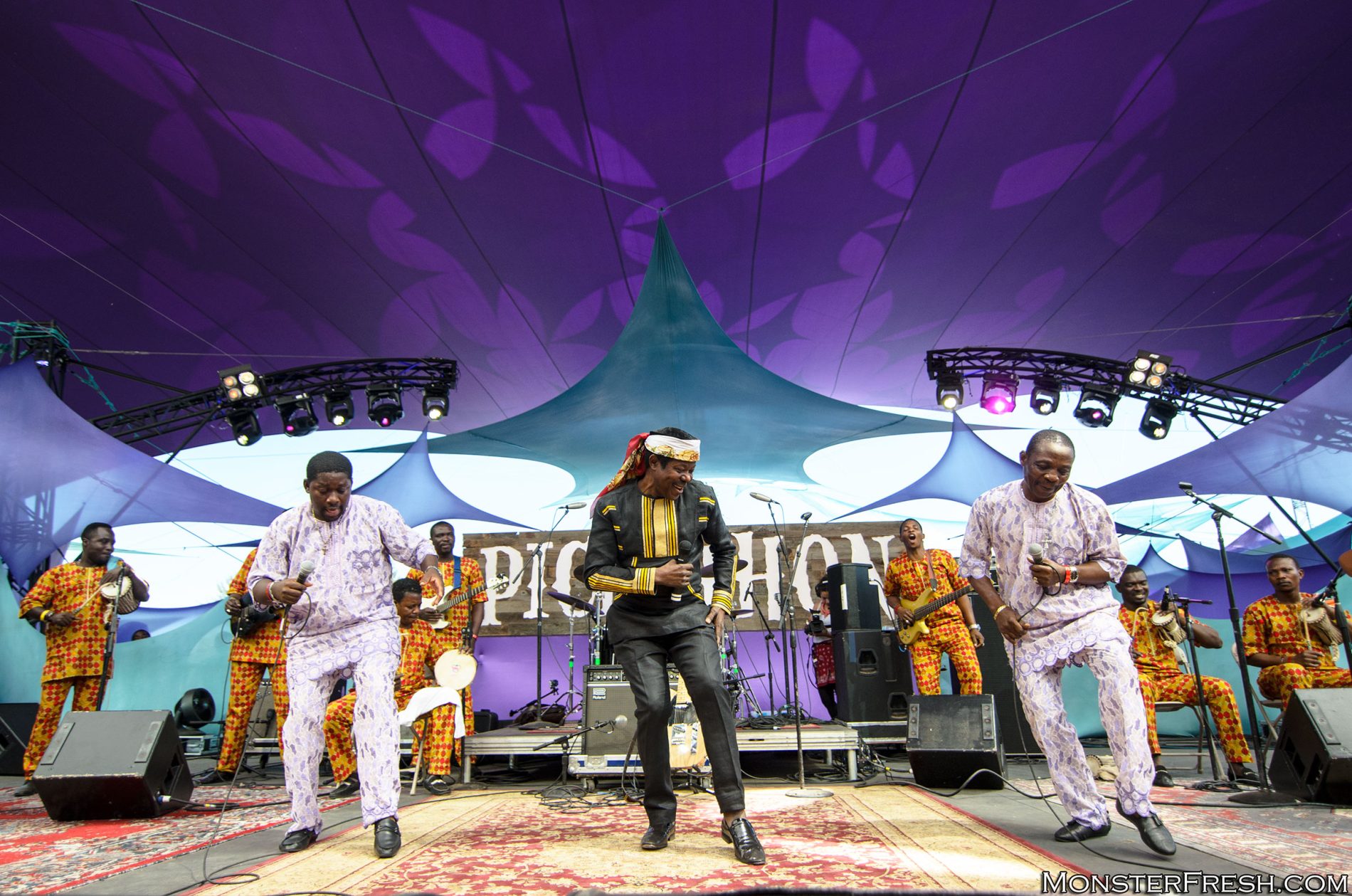
King Sunny Ade isn’t simply the king of juju music, he was, literally, born into the Ondo royal family in Nigeria and grew up exposed to traditional music at the palace. Against his parents wishes, he famously ran away to the capitol of Lagos to play music as a teenager, eventually forming his own band in 1966. Although he’s been referred to as “the Father of Juju,” the genre has actually been around since the 1920s, finding it’s roots in various shrines. He is, however, recognized as its foremost innovator, incorporating such elements as pedal steel, synthesizers, clavinet, vibraphone, and tenor guitar into the polyrhythms and traditional instruments like the talking drum, which are trademarks of Juju. Furthermore, Ade is not only responsible for bringing the style wider attention, but for shining an international spotlight on African music and world music, in general. In fact, when he was signed to Island Records and released his critically acclaimed LP, Juju Music in 1982, he was viewed as somewhat of a replacement for Bob Marley who died a year prior; at least in regards to being the next big world music figure. That didn’t exactly pan out, with The Chariman, as he is often referred, never fully embracing western marketing suggestions, continuing to stay true to his art form, while singing in the traditional dialect of Yoruba. He did become the first African ever to be nominated for 2 Grammy‘s, but his successes outside of Africa is, generally, one that is more of global, cultural, and artistic influence, rather than strictly based on commercial standards.
Bringing in international musicians like this is something that Pickathon is great about consistently working into their formula, and Ade is a huge name that I’d always hoped to catch live. With a band that’s easily 20 members deep and all dressed in African patterns, he put on a hell of a show, complete with synchronized dance moves. The joy that radiated from his performance was as infectious as the grooves.
![[From Left] Evan Burrows, Cyrus Gengras (Kevin Morby Band), Cory Hanson, Meg Duffy (Kevin Morby band), & Kevin Morby](http://monsterfresh.com/wp-content/uploads/2016/08/morby-and-crew.jpg)
It’s true that we’d already seen Morby the night before, and even that I made the effort to show up a day early just so as to avoid future scheduling conflicts, but he was really fucking good, so we saw him again. It’s a choice that I stand by; like cold pizza, he was just as good the the next day. King Tuff stood at the side stage and, at one point, even tried throwing a hacky sack toward Kevin, while he was performing. This prompted the frontman to include the announcement of, “King Tuff on the hacky sack!,” while listing off his band mates, later in the set. If one was to peruse Kevin Morby‘s instagram they would see that the hacky hijinks (or “hackjinks”) was in full effect all weekend — King Tuff‘s account even features a clip of Morby pulling a similar move, successfully setting up his old pal, Jarvis Taveniere of Woods for a mid-set hack, during their performance at Woodsist fest late last month.
![[From Left] Cory Hanson, Ty Segall, & King Tuff](http://monsterfresh.com/wp-content/uploads/2016/08/cory-ty-tuff-at-Morby.jpg)
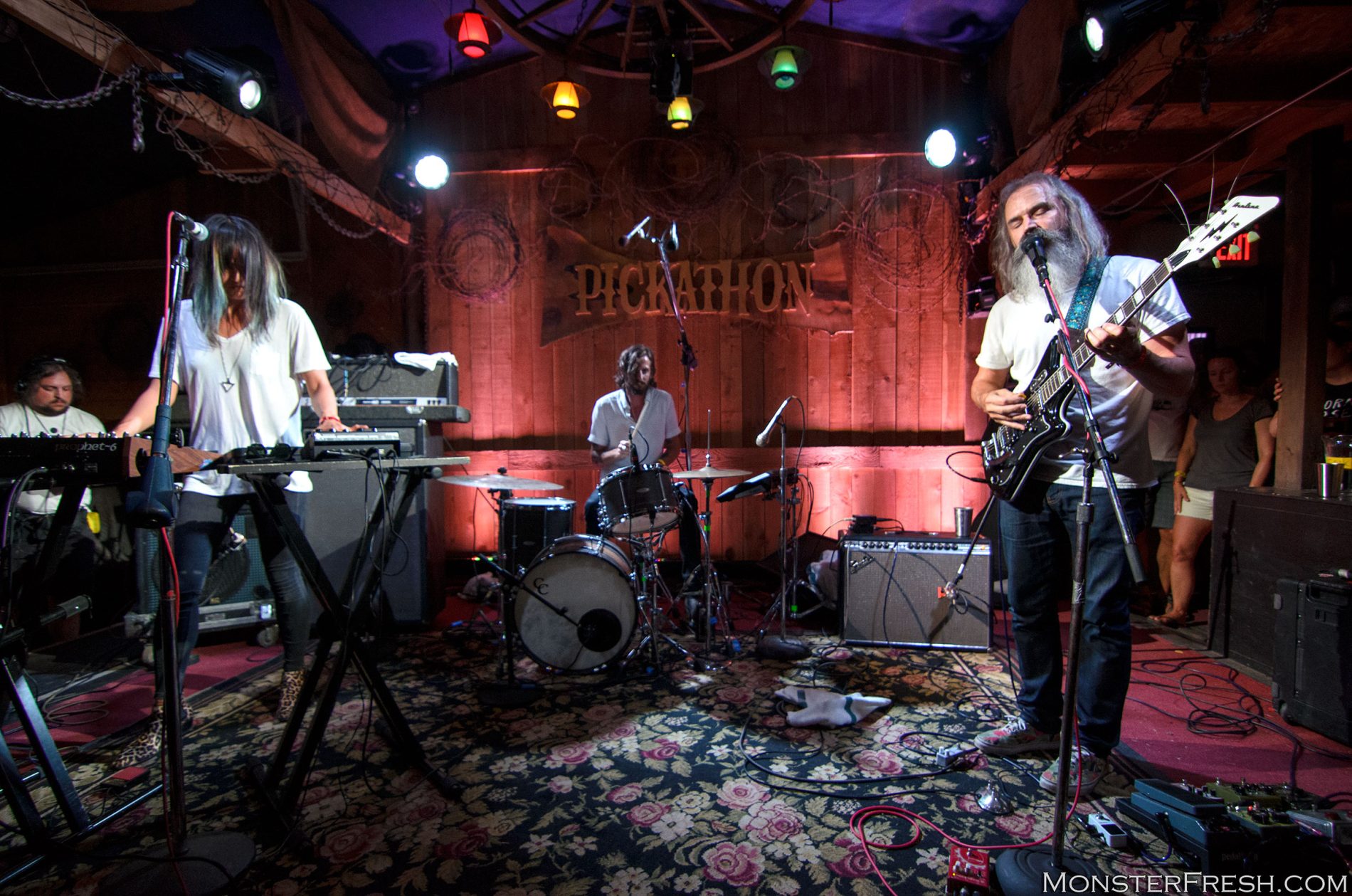
Dan Deacon‘s mini performance/Q&A in the packed, sweltering Lucky Barn was too much to deal with and, since he had 2 more sets over the weekend, we opted to get into the Galaxy Barn early and post up for Moon Duo.. The first thing that I noticed when they were setting up was that they now had a drummer, because I seemed to recall them only being a 2-piece when I saw them back in 2011, around the time that their Mazes album was released. Then it hit me; of course the drummer was new, or else they would have been called “Moon Trio.” His addition is welcome, providing more opportunities for live fluid experimentation, as their sound and material have continued to evolve.
The first time that I ever heard their music playing anywhere, the blankets of sustained fuzz instantly reminded me of Spacemen 3, so when I discovered that Moon Duo was the project of Ripley Johnson, the vocalist/guitarist of San Francisco psych rock outfit, Wooden Shjips, it made perfect sense. There are some definite similarities between both of Johnson‘s projects, including his effected vocals and the formula of laying out waves of spaced out sound for him to penetrate, snaking guitar solos throughout. What differentiates this project, which features Sanae Yamada behind a pair of synthesizers, is that there is something that’s more brooding and mechanical to it. Much of their tracks possess swirling tornado-like flesh loosely clinging to hydraulic skeletons of locked, yet propulsive beats. There are glimpses of krautrock in the repetition and of experimental electronic pioneers Silver Apples and Suicide, but Moon Duo have managed to forge all of these elements into a sound that is identifiable as their own. Sometimes it’s the sound of a smoke billowing jet turbine having a sitar pushed through it in slow motion.
I saw Ripley and Sanae a couple of times over the weekend, but they always seemed to be eating, so I never wanted to bother them for a photograph. I finally ran into Johnson the day after the fest had ended, while folks who had camped there were still getting their shit together and milling about. I expressed to him how happy I was to see them on the bill of a festival, because I had tried to photograph both of his bands in the past, but each time, they had the house lights turned off. He laughed saying, “Yeah, we like to play in the dark.” According to him, they were supposed to be taking a break from playing this year, but, somehow, wound up doing the festival regardless.

We watched from the sidestage area, while Cairo Gang played the Galaxy Barn, and I was only half-surprised to see Ty Segall behind the drumkit. I first discovered Kelly‘s work through the 2010 album, The Wonder Show Of The World that he made with Bonnie “Prince” Billy, and everything else that I’ve heard from him has been solid, yet born from a similar place of beautiful pastoral indie folk. The stuff that he was playing now as a 3-piece rock outfit was quite a bit different and slightly difficult for me to fully digest in that environment at that point of the day, but I enjoyed what I heard and am interested in finding out more about what he’s doing. I just trust Kelly‘s chops as a songwriter, in general. I ran into Mikal Cronin as we were leaving and he told me that Emmett was working on a new Cario Gang album with Ty, confirming that everything that he’d been able to hear was sounding really good.
I’ve seen Mac DeMarco a number of times now, and it’s either that I never quite know what to say, or I’ve said so much that I’m not sure what there is left. To remedy this, I’ll start off by recycling a couple of old descriptions that I’ve used in the past. 26-year-old “New York-based Canadian export, Mac DeMarco plays a screwy blend of jangly indie-pop and neo-AM Gold that he refers to as “jizz jazz,” and the kids love it.” “Mac’s persona — an odd, self-assured/comforting mixture of crude transient uncle and seasoned lounge act, who’s “been there” — accents what can easily transition from soothing to unruly live act.”
What I think is important to note is that, while Mac comes across as a jokester and likes to crack wise, he’s actually an incredibly nice guy, who I believe is genuinely appreciative and humbled by the opportunities that he’s been able to achieve. I say this only because I have noticed that, in certain circles, there seems to be a stigma about the man and a stereotype that his fans can be douchie MTV’s Real World-style cool kid types. Although, I’ve ran into a few myself — generally, much younger kids — I believe that his appeal stretches far beyond that and, as the ghosts of Kurt Cobain and 1986 Licensed To Ill tour MCA would tell you, even if that was his primary demographic, which I really believe has been exaggerated, you can’t always choose your fanbase, anyway. After all, I didn’t encounter one snotty jerkoff the entire festival and Mac‘s stage was packed. What I believe is that DeMarco is sometimes misunderstood in much the same way that Stephen Malkmus has been for decades. Both of them are really great live performers that generate dry banter throughout their sets, but neither of them are ever talking down to their audiences at all, or doing it because they believe that they are hot shit. Rather, it’s quite the opposite, as they both recognize that the classic “rock star” archetype is a fairly absurd one and acknowledge that outright, poking fun at that idea, while choosing to embrace what is so amazing about being able to get on stage and perform for the people that support them.
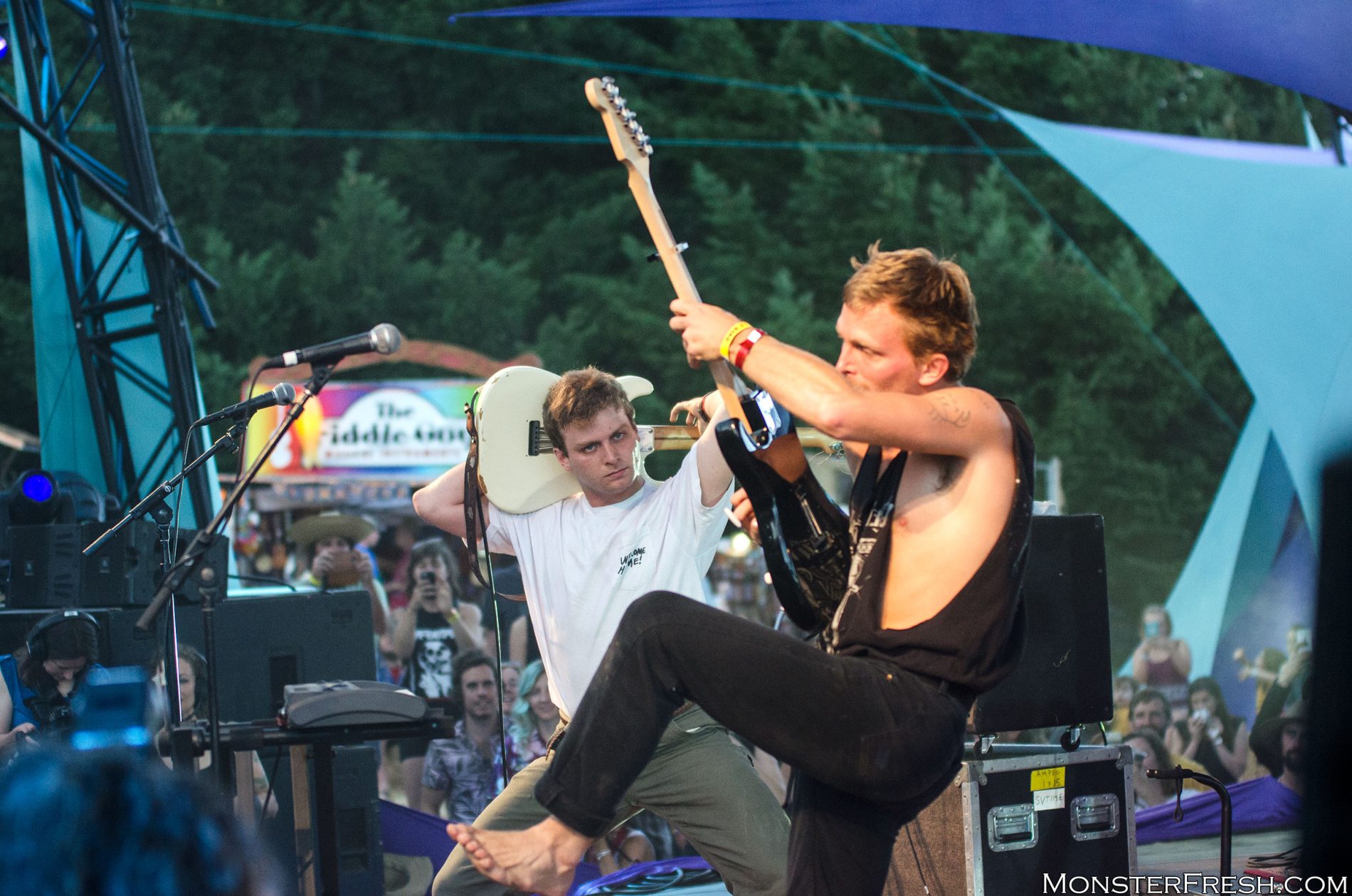
Every time that I see DeMarco he puts on the same type of show, and by that, I mean that he never quite does the same show. I saw both of his sets the last time that he played Pickathon in 2014 and then saw him perform two sets in the same day at Bumbershoot less than a month later, and the energy felt completely fresh each and every time. He has a rare sense of comfort on that stage, but the support that he feels from his bandmates is tangible. It hit me that, in the two years since he played here, his band has transitioned into both a different guitarist and a different bassist, but the dynamic has pretty much been sustained. Mac is a multi-instrumentalist who writes; performs; records; and, even sometimes, mixes, his own material, so that comfort that he feels toward his bandmates stems from the fact that he typically works with old friends from the way back. With bassist Pierce McGarry off doing other things, guitarist, Andrew White has taken on the role of right-hand wise-acre, interacting with the audience and making jokes about his guitar being constructed from human bone. In the end, I’m sure that a good portion of the intention is to see if they can make each other laugh, first and foremost. They even broke away from the originals, momentarily, to perform Steely Dan‘s “Reeling In The Years,” complete with a mid-song jam, which featured Mac; Andrew; and bassist, Jon Lent all facing each other in a triangle, while playing solos behind their heads.
Every Mac DeMarco set ends the same way, with him singing the ode to his girlfriend Kiki, “Still Together.” This song provides him with a moment to show off his vocal range, allowing his voice to soar like Roy Orbison during the chorus. For anyone convinced that he’s just fucking around up there, this is where he proves his talent, right before breaking in the middle to fuck around again. Lighting a cigarette, he plops his ass down on the stage while Andrew provides a guitar “solo” interlude, which consisted of a single note being dramatically plucked over and over again. DeMarco looked on in fabricated awe until his smoke ran out and then mischievously slipped off his socks and trademark red vans, dove onto the crowd, eventually surfing back to the stage in time to finish off the song. Before leaving, he warned that, although he has a hotel, he might wind up needing to crash in someone’s tent, if he parties too late and misses the last shuttle of the night again, like he did two years ago.
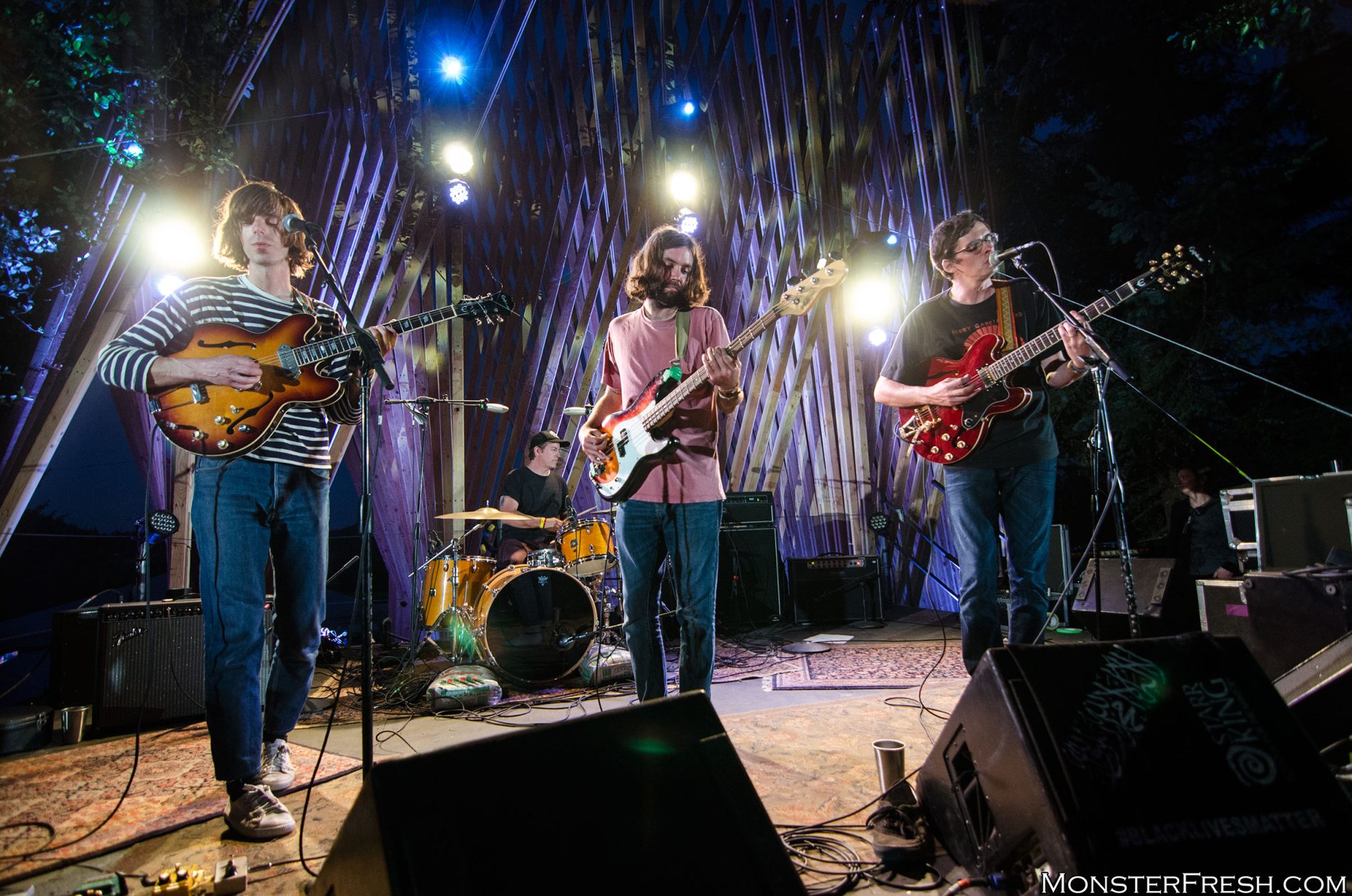
Heading back to camp to get our coats, we stumbled past Ultimate Painting on the Treeline Stage, so we decided to sit down on the grass and check out the British indie rock outfit. My only experience with the band came recently when I watched a streaming in-studio performance that they did for Seattle‘s KEXP radio station. I remembered liking them, and I remembered that they liked The Velvet Underground. The fact is that you’re likely going to be hard pressed to find a review of the group anywhere that doesn’t reference VU and, more specifically, the legendary NY band’s self-titled third album. But where UP shines and what sets them apart is their nuance. The project was formed by a pair of frontmen from two separate indie groups whose names I’m aware of, yet have no history with: James Cooper of Mazes and James Hoare of Veronica Falls. Trading songs and vocal duties, it’s the subtle interplay of their guitar lines that really stands out and, at times, even casually hints at the Grateful Dead; the fact that Cooper was wearing a Cats Under The Stars shirt confirming that influence. Whatever the last song was, they jammed the shit out of it and won me over, proving that they are more than a couple of laidback songsmiths penning laidback tunes, but actual musicians that are capable of conjuring up some impromptu sonic mayhem, when necessary. Like a quick little sonic keybump, it woke my ass up. Apparently, the band derived their name from a large, round, 5-foot diameter, psychedelic painting created by a mid-60s / early-70s counterculture art community that resided in geodesic domes in Colorado. Even crazier is that there were actually little geodesic half-dome structures behind the stage, while we were watching them.

While the Treeline Stage looked impressive during the day, with it’s large natural wood beams fanned out in sections to create the backdrop, it looked even more amazing at night as the colored stage lights illuminated it through the slats. What I hadn’t noticed earlier was that behind the backstage there was a row of wooden steps leading down to a covered area filled with picnic tables, flat screens broadcasting the performances from the stage, and those little half-domes that I mentioned before, provided shelter for those that wanted to lay back and relax to the stream. The story is that the whole marvelous setup was designed by Portland State University architecture students and the wood was all slated to be repurposed after the festival. At the foot of all of this were food vendors, including one selling wood-fired pizza.
As we waited for our pizza, I noticed Ty Segall doing the same, while sporting a white blazer a-la Robert Downey Jr in Less Than Zero. We spoke briefly and he told me that he’s been to just about every music festival in the united states and this is, pretty much, the only one that he actually wants to hang out at. He would be playing the Galaxy Barn later that night, so I mentioned how hot it can get in there, to which he responded that he was down with that, too. He added that he’s a big fan of seeing bands in small bars and here they, basically, had one. He then asked why anyone would want to see anything else. Now, as I type this, I realize that there is a strong possibility that he may have, actually, said “barns.” Either way, his pizza was ready, so he headed up to the Treeline Stage to catch La Luz, whose latest album he produced for them.
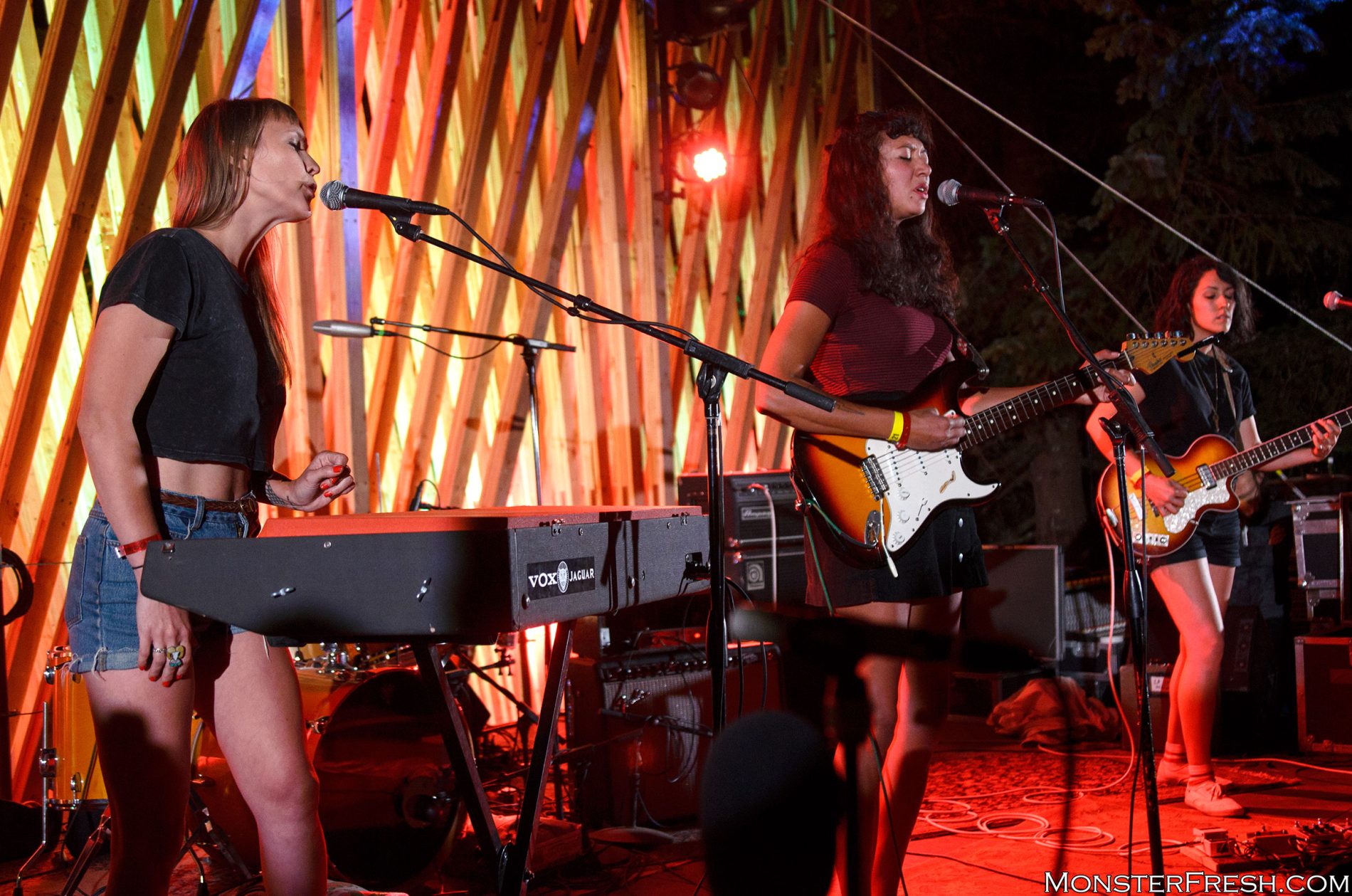
La Luz is an all female quartet noted for their throwback surf-rock and doo-wop elements. You’re going to hear that term a lot, whenever they’re referenced: “surf rock.” “Dick Dale.” “Women.” “Harmonies.” It’s not that these descriptors aren’t apt or even helpful, to a limited extent, but there’s a lot more to the music that they produce than any simple gimmick, or outside reference point. La Luz may be pulling from particular influences, but they are definitely more than what they enjoy; they are pretty damn good songwriters. If they didn’t have talent or variety in their catalog, it would have been curtains a long time ago. Equally as important, they don’t fall into the trap that a lot of bands do of sounding one dimensional, while infusing their work with such identifiable styles. It’s not that they couldn’t do a top notch job of scoring a season of Venture Bros, because they definitely could, but, if anything, they’ve demonstrated to me that there is more dimension to those styles that they are drawing from and an endless number of directions to take them in, if you know what you’re doing and your approach is authentic.
La Luz is from Seattle. I’m from Seattle. There are opportunities to see them later, but for now, we needed to head up that trail and go catch Yo La tengo.
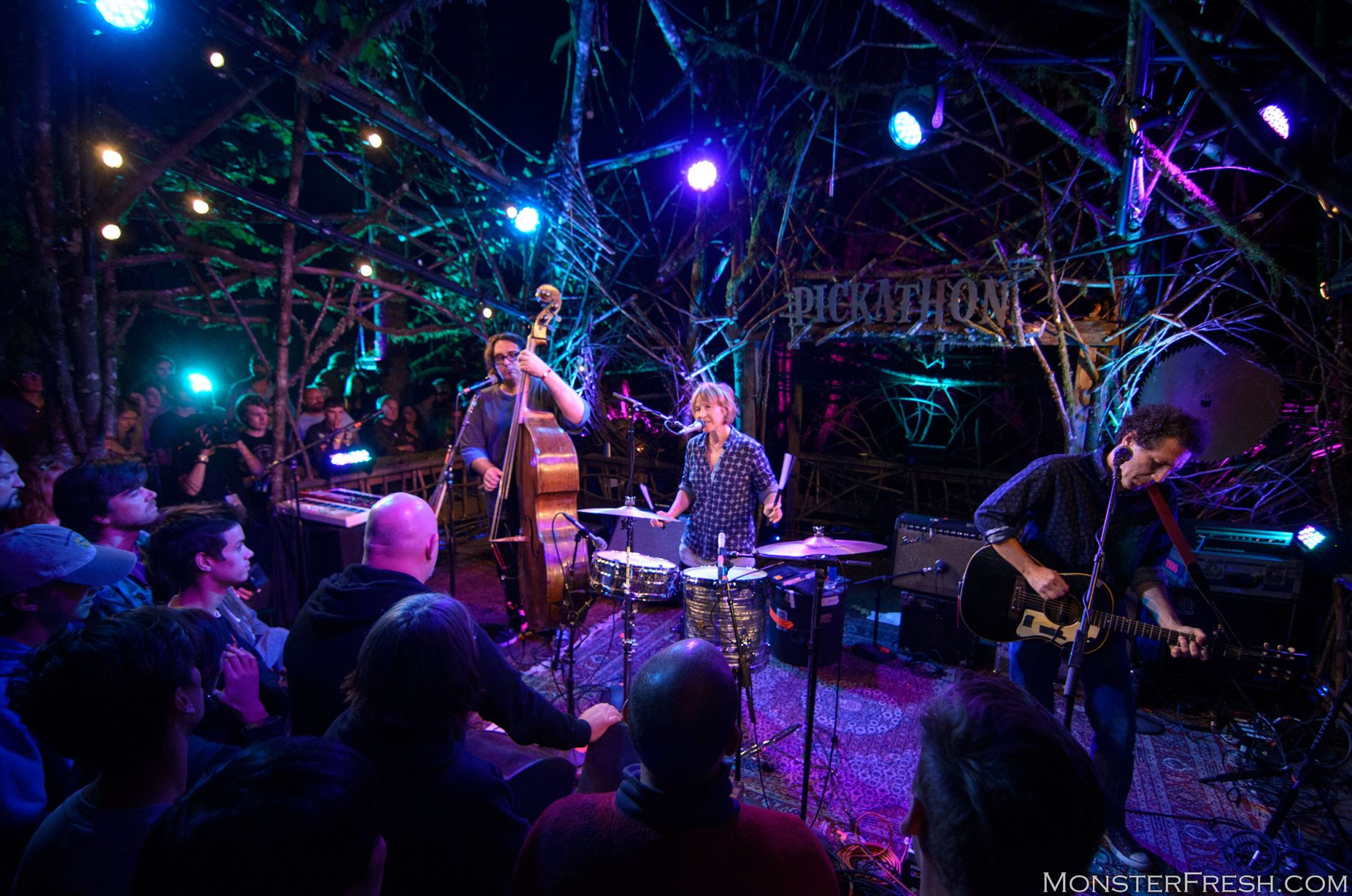
This was one of my favorite sets, if not my favorite, of the entire weekend and I’m at somewhat of a loss as how to even begin to describe it — hopefully, the photo above will provide a slight level of assistance, in lieu of my abilities. Yo La Tengo has been together for 32 years and something about seeing them perform feels like that fact is both impossible and that it has to be true.
Doing an acoustic set on The Woods Stage, Georgia Hubley positioned herself behind a drumkit center stage, flanked by bassist, James McNew with an upright, and her husband, Ira Kaplan holding a guitar, to either side. As they provided samples from various eras throughout their extensive discography, everything felt effortless. Even just on sight, their discography itself seems effortless, with these 3 longtime collaborators consistently having something new to offer every couple of years or so, without fail. Whether they were trading vocal duties or Hubley was transitioning from her drums to a keyboard positioned toward the front of the stage, there was a patience and knowing comfort to everything. I can’t recall ever witnessing that level of balance anywhere; certainly not in my own life. Ira Kaplan may be the frontman by default, but no one member ever feels more vital than the others. Not only is Yo La Tengo truly the sum of the people involved, if any of them ever felt otherwise, we’d never know it. While they’re performing, the fluidity is mesmerizing; any signals traded, invisible.

Their enigmatic band name, which translates to, “I got it,” has likely puzzled fans for years. Or, perhaps, it hasn’t; maybe, there’s something that the hardcore ones know. I myself, have never been a “hardcore fan.” I’ve never delved deep into that daunting discography. What I know is what I’ve heard and what I’ve heard, I’ve thoroughly enjoyed, but it just never happened to be one of the many things that I’ve invested in. Being able to finally see them for the first time, this was an opportunity to get a taste of what the hype was all about. The idea that, with only limited knowledge of a handful of the songs that they performed, I found myself thinking, “Maybe, this is my favorite band“… it’s something. I know that they’re classified as an “indie rock” outfit, but even within the confines of an acoustic set — they also have the ability to blow your ears out if they wanted to — they fully transcend that label. The versatility is so organic, the shifts chameleonic, both in the way that they create and in the way in which they operate among each other. Somehow, this band sounds like everything, while at the same time, not quite sounding like anything else. I suppose that “Yo La Tengo” could mean a number of things, but witnessing them in their zone with complete control of that environment, it seemed to reflect a level of unconditional trust that they had in each other to support whatever delicate creation they were birthing and nurturing in real time. Collectively, they are a weather machine as much as anything. Even beyond what they have in each other, they have to have faith in the material, as well as the process. It’s endlessly inspiring to see a collaboration of that level, abandoning shallow theatrics and holding the complete attention of a tired, wounded mob with something so true and honest. But hey, they’ve got it. This is exactly what they’ve been doing for the last 3 decades, holding the attention of legions.
That being said, I’m obviously not Yo La Tengo and I lack their endless focus and patience, so I’d like to publicly state that, while it’s great that you can sing every other few handfuls of words to their cover of The Cure‘s “Friday I’m In Love” into my ear, and/or feel compelled to let them know that you’d like them to rock out a little harder during their acoustic set, don’t do it. I was having a fucking moment there.
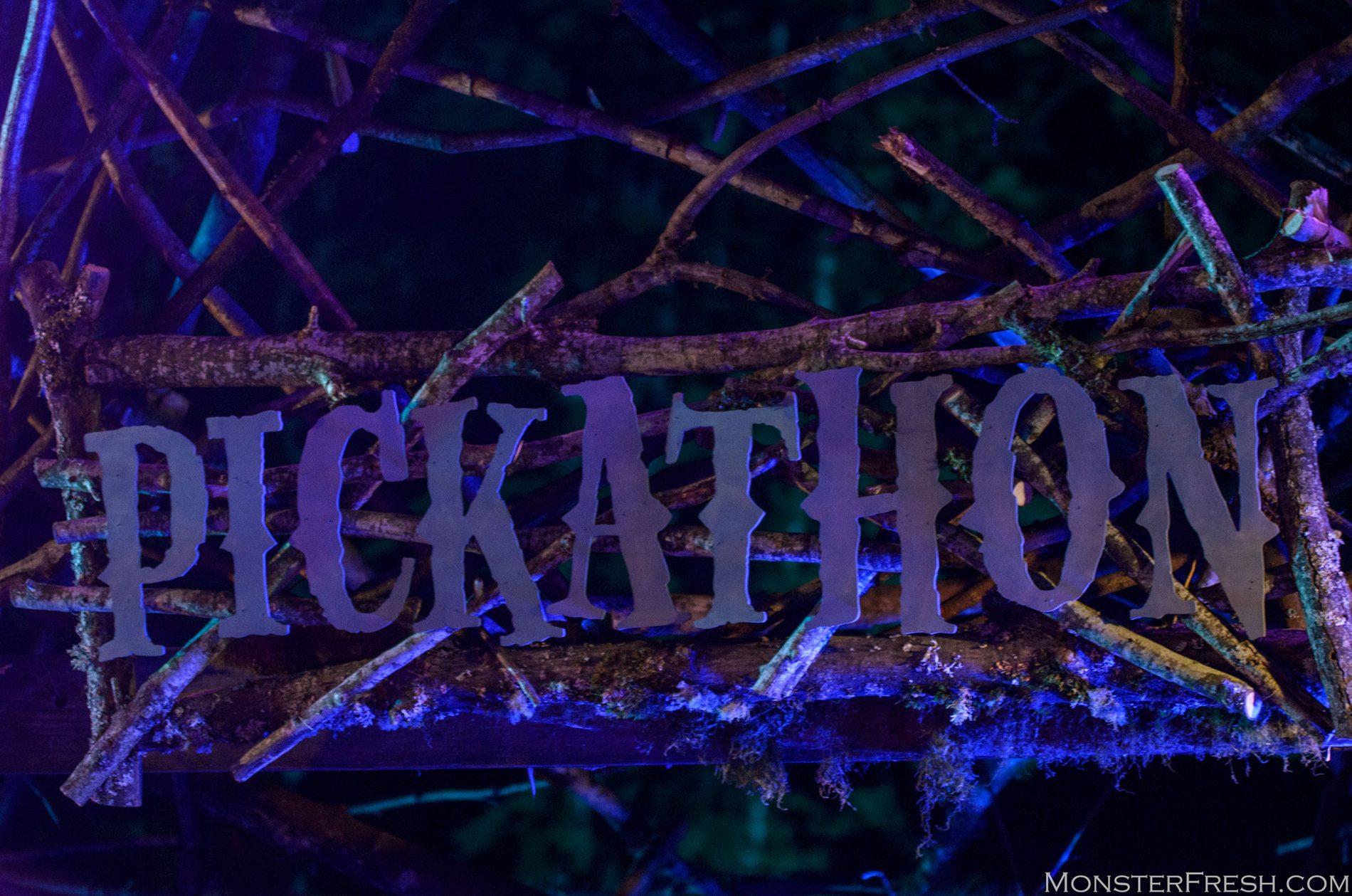
Heading away from The Woods stage, we ran into Pickathon founder, Zale Schoenborn on a trail and he told us to follow him deep into the woods to the pumphouse. So… we did. I’ve been aware of the pumphouse every year, but I’ve never actually made it out to it, before. As Zale explained it, it’s kind of like “a living room” for the artists and, apparently, anyone who has the correct wristband. You can find videos of live performances that were recorded up there on youtube, a number of which are set up last minute. Something special was going on tonight, but, unfortunately, there were some issues with a breaker that had left everyone out there in the dark. The lights would kick on temporarily, but then cut out again, while they were looking for a permanent fix. When they did come on, I understood the living room comparison immediately. There was a couch and a lamp, a table, I believe… basically, a living room. Then there was weird shit, like a tree with several round analog clocks extended up the trunk like some bizarre Alice In Wonderland scenario.
Behind a large table of electronics was Dan Boeckner and Arlen Thompson of Wolf Parade, preparing to perform some live acid-house, synth, and drum machine situation. The problem was that, every time one of them would hit something, they’d get about four blips out, before the electricity went kaput. Wolf Parade was one of the headliners this year, but guess what kids, I never got into those guys. Not that I wouldn’t or, possibly, couldn’t, but I just never really listened to them. So, while a lot of you out there would have shit yourself to watch this, I was looking at the time on my phone and realizing that the Ty Segall & The Muggers set was steadily approaching. We had absolutely no fucking idea where we were at anymore, and we’ve been sitting in the dark on and off for a good 15-20 minutes. It sounded like they might be about to solve the problem permanently, but we’d already decided to bounce. So… turns out that it did go down and that they played for about an hour. Plus, I believe they might have been joined by fellow Wolf Parade band member, Spencer Krug. From what I’ve learned recently, the project is being called Frankfurt Boys and I wouldn’t be surprised if you heard something from them in the future, even at Pickathon. Boeckner, who has also performed at the fest with his other projects, Divine Fits and The Operators, in the past, has joked that he only keeps starting new bands, simply so that he can get them booked to play the festival.
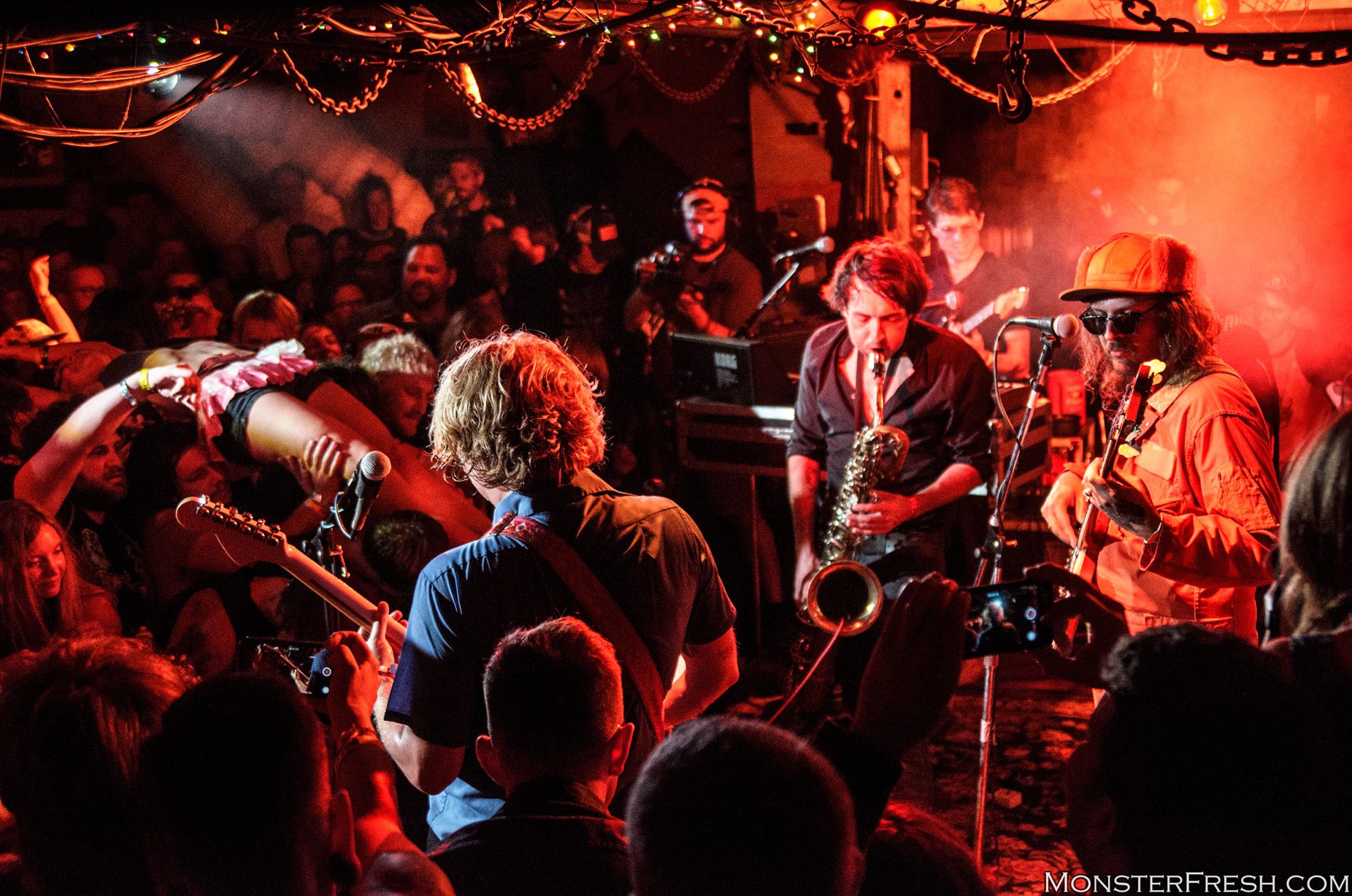
It was pretty rough trying to squeeze into the back/sidestage area of that hot ass barn to get a glimpse of the Ty Segall & The Muggers set, but while I spent the majority of the time with an extremely limited view, I could gather the basic gist of what was going down. Ty was still wearing the blazer, but he wasn’t rocking the rubber baby mask that he’d been donning with this lineup. King Tuff, however, didn’t mind wearing a furry construction worker orange hunting cap in that sauna. Segall doesn’t touch a guitar for most of their shows, but he doesn’t really need to, with Tuff, Emmett Kelly, and Cory Hanson — who alternates, occasionally, from behind the keys — all capable of tearing out some blistering solos. This band is full of multi-instrumentalists and it would almost be too much, if too much wasn’t their bread and butter. Segall relished in the chaos, pointing and screaming toward the crowd and placing his hands intensely onto foreheads. At some point, a girl came on stage and, somehow, was connected to a spacesuit that Ty was holding up. To be honest, I don’t know what the fuck was going on other than the fact that people were flying around, both on stage and off. Toward the end, it was nice to see Mikal Cronin break out his saxophone, shuffling his bass over to King Tuff who, in turn, gave Ty the guitar. From what I remember, I believe Segall had announced, “This is our last song!” before a few of them in a row, until finally finishing the night off with an extended classic rock medley that included “LA Woman,” a Sabbath cut, and “House Of The Rising Sun.”
As everything died down, we headed out back into the cool night air to compose ourselves, before heading back to the tent. Technically, this was only the first official night — the rest would be moderately less insane, by choice. A hooded figure walked up to the upright piano near us and, as he sat down, I noticed the red shoes on his feet. He chopped away at the keys for a little while, until he was pulled away by a small crew urging him to get up and reminding him that they were trying to head to Denny‘s. He needed this ride. I’m pretty sure that the last shuttles had already left for the night.